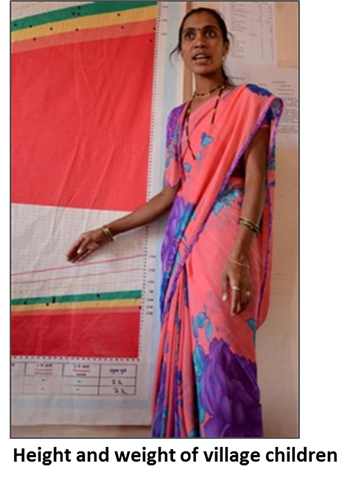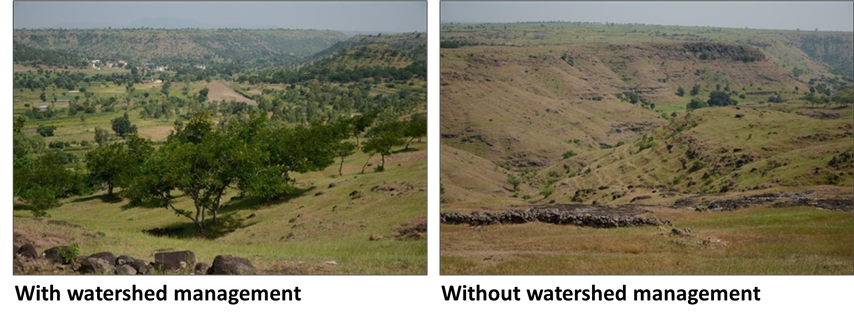The multiple benefits of working with WOTR: what the ASSAR team learned on a guided field trip in Maharashtra
by Tali Hoffman (University of Cape Town) and Bhavana Rao (WOTR)

Based in Pune, India, the Watershed Organisation Trust (WOTR) is an NGO that has been designing and implementing ecosystem-based watershed development projects since 1993. Working in seven Indian states, WOTR - one of the key practitioner organisations in the ASSAR consortium - has a mandate to “reduce poverty through mobilising the self-help capacities of individuals and communities to regenerate the eco-spaces or watersheds they live in, harvest rain water wherever it falls, use it productively, undertake sustainable livelihoods and do whatever else it takes to get them out of poverty.” (see the WOTR website). Over two days in October 2014, members of the ASSAR team had the opportunity to witness first-hand some of the incredible work that WOTR is doing in the Maharashtra region of India.

We were warmly welcomed to WOTR by one of its founding members - Crispino Lobo - who described the history and rich philosophy that underlies WOTR’s work. He explained that WOTR’s ecosystem approach builds both “hard” and “soft” resilience in communities by building multiple environmental and social themes into their watershed development work. These include: climate change adaptation, agro-meteorology, water budgeting, biodiversity, disaster risk reduction, sustainable agriculture, sustainable livelihoods, alternative energy, sanitation, health and nutrition, policy advocacy and the empowerment of women.
Crispino explained that the investment in the “soft” development themes have been the key to WOTR’s success over the last two decades. This success was evident throughout our visit as we were continually greeted by community members in multiple villages, who happily recounted to us the ways they have been empowered to better manage their watershed ecosystems, and the social, environmental and economic benefits they have experienced as a result.

The first field visit was to the village Khumbarwadi where watershed development was implemented 15 years before. During this visit two key activities were shared by the village community coordinator. The first activity explained by the community member was how they apply WOTR’s water budgeting tool in their village to use water they have more efficiently. This budgeting system allows his community to keep track of all the surface and ground water available in their watershed thus using it optimally. The budgets consist of two kinds of information. The first relates to water availability in the village and the second relates to amount of water usage /required by the village for various activities. Based on this the communities calculate how much water they need for their households, crops and livestock every season. These two pieces of information are displayed publicly on a board in each village, so that everyone can see exactly how much water is available for each purpose and for how long.

There is enormous value in this budgeting process as watershed development practices typically result in a large increase in the amount and availability of water. This can lead to excessive water use that greatly reduces the life span and long-term benefits of the watershed. However, by budgeting carefully, and by managing this water effectively, communities can ensure that they have water available to them across the seasons and for years, if not decades, to come.
The second activity was on “agro metrology”, a process whereby communities receive crop-specific weather reports – called agro-advisories – for the agriculture in their village. The coordinator showcased the Agromet Station in his village, explaining how his community benefits from the agro-advisories that they receive via sms on their mobile phones.
In a second village called Bhojdhari we were greeted by a large group of confident and knowledgeable women who were animated in their explanations of how WOTR has empowered them to monitor the many aspects of their communities and environment. They showcased the “Growth Monitoring” charts that they use to track the height and weight of the children in their village, and explained how they manage nutrition to ensure undernourishment is avoided. They explained how they use the “Co-DriVE - Visual Integrator” tool to manage the local risks associated with climate disasters. They described how they grow a diversity of crops throughout the years, targeting certain crops in certain seasons, to make sure that food is available year-round. The women also shared how they track the local biodiversity using the “People Biodiversity Register” so that they better understand how the plants and wildlife patterns vary across seasons and across years.â
The landscape we drove through mirrored the positive stories we heard, as we saw clear and stark contrast between managed and unmanaged watersheds. Managed areas boasted greenery, crops, trees, and water, while unmanaged areas were barren, dry and unproductive.

This field trip gave the ASSAR team a well-rounded and tangible sense of what effective and relevant climate change adaptation can look like. Furthermore it provided a clear demonstration of how continual stakeholder engagement and a multi-sectoral, multi-disciplinary approach can help even the most vulnerable people to thrive in the face of variable climatic conditions.